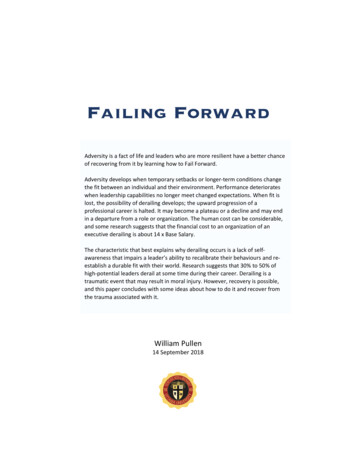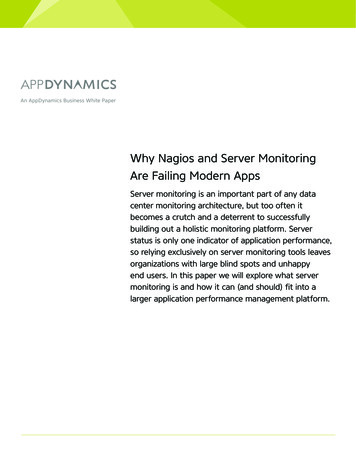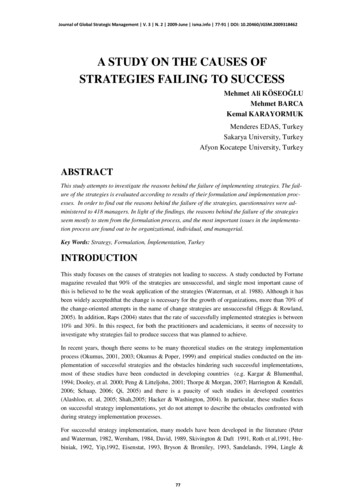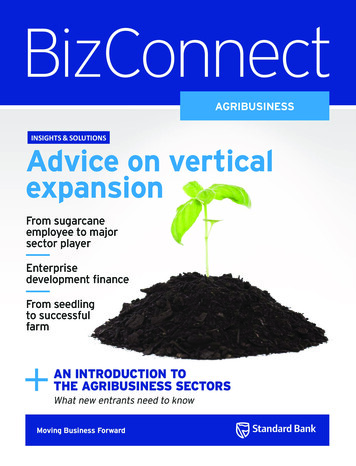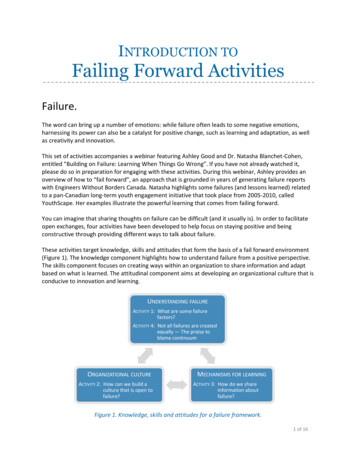
Transcription
INTRODUCTION TOFailing Forward ActivitiesFailure.The word can bring up a number of emotions: while failure often leads to some negative emotions,harnessing its power can also be a catalyst for positive change, such as learning and adaptation, as wellas creativity and innovation.This set of activities accompanies a webinar featuring Ashley Good and Dr. Natasha Blanchet-Cohen,entitled “Building on Failure: Learning When Things Go Wrong”. If you have not already watched it,please do so in preparation for engaging with these activities. During this webinar, Ashley provides anoverview of how to “fail forward”, an approach that is grounded in years of generating failure reportswith Engineers Without Borders Canada. Natasha highlights some failures (and lessons learned) relatedto a pan-Canadian long-term youth engagement initiative that took place from 2005-2010, calledYouthScape. Her examples illustrate the powerful learning that comes from failing forward.You can imagine that sharing thoughts on failure can be difficult (and it usually is). In order to facilitateopen exchanges, four activities have been developed to help focus on staying positive and beingconstructive through providing different ways to talk about failure.These activities target knowledge, skills and attitudes that form the basis of a fail forward environment(Figure 1). The knowledge component highlights how to understand failure from a positive perspective.The skills component focuses on creating ways within an organization to share information and adaptbased on what is learned. The attitudinal component aims at developing an organizational culture that isconducive to innovation and learning.UNDERSTANDING FAILUREACTIVITY 1: What are some failurefactors?ACTIVITY 4: Not all failures are createdequally — The praise toblame continuumORGANIZATIONAL CULTUREACTIVITY 2: How can we build aculture that is open tofailure?MECHANISMS FOR LEARNINGACTIVITY 3: How do we shareinformation aboutfailure?Figure 1. Knowledge, skills and attitudes for a failure framework.1 of 16
Approaching Failure with a Positive AttitudeThe following mindsets are helpful to ensure you get the most from this material: Stay willing and oriented to learningo Be open to new ideas and continuously think of opportunities in your day to day lifewhere they can be appliedo Draw from your own experiences to enrich your depth of understanding Internalize the locus of responsibility for creating changeo Avoid placing blame externallyo You can always do something: even if you may only impact 1% of a solution, focus onthat as your responsibilityo People learn in practices so seek out others who are willing to join you as you apply andpush these ideas further within your own organization or context Keep in mind that engaging with failure in new ways is inherently challengingo It is therefore important to celebrate all the steps forward – big and small Don’t worry and enjoy the learning!o It may be challenging and new, but if you stick to your ground rules (see below) you’reguaranteed to learn from the experienceGround RulesDiscussing failure can be a sensitive process, so it’s important to set some ground rules for everyone tofollow as you explore new ideas (especially when sharing your failure stories). Some suggestions for yourgroup work include acknowledging that: People share what they believe to be trueOpinions need to be respectedDifferent perspectives are relevant, useful and validYou respect your fellow participants and hold each other in high esteem as hardworking,worthy individualsBeing respectful to each other is criticalEveryone in your organization is doing their best and making decisions based on theirexperience and the information available to themEveryone comes with their own sets of assumptions that can be articulated and tested forvalidityIt’s easy to criticize because nothing is perfect; better than criticizing is working with othersto improve their good ideasStories should be genuinely self-reflective (blaming others is damaging to the group andinhibits learning)Just because someone fails, does not mean they are a failure; decoupling ego from activity isa part of the learning from failure experienceFeel free to adapt this list to meet the needs of your particular group.The activities that we have provided are suggestions on how to lead discussions on failure in aconstructive manner. As they are not perfect, these activities can benefit from your suggestions aroundhow to make them more effective in facilitating open exchanges around failure. Once you have tried2 of 16
them out, feel free to contact Ashley Good (ashleygood@admittingfailure.com) with your comments,questions, or to discuss how your organization may take these ideas further.Best wishes on failing forward!Ashley Good, Founder and CEOAdmittingFailure.comKevin Chin, Ph.D., Knowledge and Evaluation OfficerThe J.W. McConnell Family Foundation3 of 16
Activity 1: What are some failure factors?DescriptionFailures can be overwhelming to think about because of their perceived complexity. In order to helpdeepen understanding of situations where things have not gone well, you can use this activity todeconstruct failure into manageable parts.ObjectivesAt the conclusion of this activity, participants will be able to: Describe experiences of failure from individual, interpersonal, and institutional levels Analyze examples of failure using this framework Explain how this framework might be used to diagnose an organizationMaterials Flip-chart paper Post-it notesTime30-45 minutesInstructionsStep 1: Deconstructing failure1. Explain to the group that there are many ways to understand failure. One way is to deconstruct itinto three different, but related, levels: Individual: Personal factors that influence engagement with failure Interpersonal: Group dynamics that influence engagement with failure Institutional: Organizational culture that influences engagement with failure4 of 16
2. Present the following image to the group:INDIVIDUALooooooPersonal confidenceThe individual's credibility and competenceEffort (self-perception and from theperspective of the organization)Personal perception of failureLevel of personal identity associated withthe work (personal vs. project failure)Level of involvement of each individual inthe work (personal vs. team failure)INSTITUTIONALooooEffort (from the perspective of theorganization)Organization's perception of failureImplications/consequences of the failureExpectations for success/acceptance of riskINTERPERSONALoooLevel of trust the team has in the individualLevel of involvement of each individual inthe work (personal vs. team failure)Comfort with and frequency ofcommunication of failure (dialogue withinthe team — suspension of assumptions)o3. Ask participants to think about additional factors that could be added to each box.4. Add these to the image in the appropriate box.5. Ask participants if any ideas are brought to mind when looking at this list of factors that helpdeconstruct failures.Step 2: Deconstructing a story of failure1. Play the TED talk video featuring David Damberger(http://www.ted.com/talks/david damberger what happens when an ngo admits failure.html).2. At the conclusion of the video, ask participants to work in pairs and identify which factors from eachlevel may have played a role in David’s experience.3. Have pairs write each of their responses on a post-it.4. Ask one person from each pair to share their responses and stick them in the appropriate row on aflip-chart sheet with this table:5 of 16
LEVELFACTORSIndividualInterpersonalInstitutional5. Ask participants the following questions: Did anything interesting emerge from generating this list? If so, what? Do any of these factors apply to your organization? If so, which? How might these factors be improved within your organization? How would this take place?6 of 16
Activity 2: How can we build a culturethat is open to failure?DescriptionDrawing inspiration from failure is greatly supported by having an organization that promotes thedevelopment and maintenance of a learning culture. This activity leads participants through a process ofbuilding on existing strengths by discussing and identifying key elements that contribute to this type oflearning environment.ObjectivesAt the conclusion of this activity, participants will be able to: Describe how control plays a part in engaging with failure State the level of risk-taking that the organization encourages Explain the types of processes that can help surface learning around failureMaterials Flip-chart paper Post-it notesTime30-45 minutesInstructionsStep 1: Framing how themes are relevant1. Present participants with a structure for framing an open culture for failure (Appendix 2.1).2. Distribute post-its and ask participants to write down examples that describe how each themeinfluences how their organization engages with failure. Remember to be respectful when sharingcomments!3. After 5 minutes, ask participants in turn to read out their examples, and attach post-its to theappropriate area of the figure.4. Ask participants to identify any patterns they might see in their responses.5. Facilitate one consensus statement for each theme that summarizes group sentiment. For example,“We feel that our organization provides a sufficient amount of space to experiment”, or “Staff wouldlike to have more support in sharing failures with one another as a learning process.”Step 2: In-depth discussion of themes1. Select one or two questions from each column to help discuss how your organization is influencedby each theme (Appendix 2.2).2. Facilitate a discussion with participants for each question selected.3. Summarize some of the key points that have emerged from this discussion.4. Ask participants to share how these three themes (control, risk-taking, and recognizing the value offailure) may be inter-related.7 of 16
Appendix 2.1: Structure for Framing an Open Culturefor FailureRECOGNIZING THE VALUE OFFAILURECONTROLMany organizations tend to eitherbrush failure under the carpet orpunish those responsible. In thisrespect the brilliant failure attitude is:"there is no such thing as failure onlyfeedback". Organizations need to putprocesses in place to recognize thevalue of "failure" and maximize thelearning from this.Control tends to suppress evolutionary,spontaneous processes. The windowsof opportunity that arise are leftunexplored with no option to capitalizeon their potential. To counter this,organizations need to examine wherethey could control less and navigatemore.RISK-TAKINGMany organizations, and employees, tend to play safe,to stay in their comfort zones. As a result theyimplicitly or explicitly take the low end of the riskreturn trade off. To counter this organizations need toexamine where, and what type of risk taking, theywant to encourage.8 of 16
Appendix 2.2: Themes for Working with Failure(Adapted from: G THEVALUE OF FAILUREControl tends to suppressevolutionary, spontaneousprocesses. The windows ofopportunity that arise are leftunexplored with no option tocapitalize on their potential. Tocounter this, organizations needto examine where they couldcontrol less and navigate more.Many organizations andemployees tend to play safe,to stay in their comfort zones.As a result they implicitly orexplicitly take the low end ofthe risk-return trade off. Tocounter this, organizationsneed to examine where, andwhat type of risk taking, theywant to encourage.Many organizations tend toeither brush failure under thecarpet or punish thoseresponsible. In this respect thebrilliant failure attitude is: “thereis no such thing as failure onlyfeedback”. Organizations need toput processes in place torecognize the value of “failure”and maximize the learning fromthis. How do you mobilize the What are the top three What mechanisms are increativity of all yourstakeholders, and of youremployees in particular, inorder to define the best wayto reach your project andorganizational goals? How does your organizationrisks to which yourorganization and project isexposed? What is the understandingin your organization ofwhat risks you would liketo encourage and whichyou want to avoid?place to learn from failure,both at the individual projectlevel and throughout theorganization, e.g., activelyrewarding employees whowent the extra mile inaddressing failure?check existing conditions and How are these learningscreate space to navigateshared with others both inside What percentage of yourthrough this?and outside yourbudget is reserved ororganization?allocated to experimental How does your organizationreact if the initial projector innovative projects? To what extent does yourassumptions and/or goalsorganization really act on On average, whatturnout to bethese learnings andpercentage of yourinvalid/unachievable? Whatimplement the necessaryprojects do you consider asdegrees of freedom andchanges in strategy andpartial or total failures?ability do you take tooperations? What mechanisms do youreadjust to the new reality?have in place to encourageproactive behaviour, e.g.,experimentationcombined with ownershipand accountability?9 of 16
Activity 3: How do we share information about failure?DescriptionOnce an organization has committed to developing a learning culture that includes discussions of failure,there needs to be various mechanisms and/or approaches for promoting and sharing learning. As manyorganizations have departmental or group silos, there is always a risk of not sharing useful informationthat could help spur new ideas. In order to build on existing best practices — and create new ones —this activity outlines how different channels of information-sharing can be identified to promote thesharing of ideas.ObjectivesAt the conclusion of this activity, participants will be
overview of how to “fail forward”, an approach that is grounded in years of generating failure reports with Engineers Without Borders Canada. Natasha highlights some failures (and lessons learned) related to a pan-Canadian long-term youth engagement initiative that took place from 2005-2010, called YouthScape. Her examples illustrate the powerful learning that comes from failing forward.
